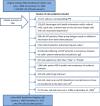Emergency Department Attendance after Telephone Triage: A Population-Based Data Linkage Study
- PMID: 28369871
- PMCID: PMC5867179
- DOI: 10.1111/1475-6773.12692
Emergency Department Attendance after Telephone Triage: A Population-Based Data Linkage Study
Abstract
Objective: To investigate compliance with telephone helpline advice to attend an emergency department (ED) and the acuity of patients who presented to ED following a call.
Data sources/collection methods: In New South Wales (NSW), Australia, 2009-2012, all (1.04 million) calls to a telephone triage service, ED presentations, hospital admissions and death registrations, linked using probabilistic data linkage.
Study design: Population-based, observational cohort study measuring ED presentations within 24 hours of a call in patients (1) with dispositions to attend ED (compliance) and (2) low-urgency dispositions (self-referral), triage categories on ED presentation.
Principal findings: A total of 66.5 percent of patients were compliant with dispositions to attend an ED. A total of 6.2 percent of patients with low-urgency dispositions self-referred to the ED within 24 hours. After age adjustment, healthdirect compliant patients were significantly less likely (7.8 percent) to receive the least urgent ED triage category compared to the general NSW ED population (16.9 percent).
Conclusions: This large population-based data linkage study provides precise estimates of ED attendance following calls to a telephone triage service and details the predictors of ED attendance. Patients who attend an ED compliant with a healthdirect helpline disposition are significantly less likely than the general ED population to receive the lowest urgency triage category on arrival.
Keywords: Administrative data uses; epidemiology; hospitals; referrals, referral networks.
© Health Research and Educational Trust.
Figures

Similar articles
-
Compliance with telephone triage advice among adults aged 45 years and older: an Australian data linkage study.BMC Health Serv Res. 2017 Aug 1;17(1):512. doi: 10.1186/s12913-017-2458-y. BMC Health Serv Res. 2017. PMID: 28764695 Free PMC article.
-
Appropriateness of cases presenting in the emergency department following ambulance service secondary telephone triage: a retrospective cohort study.BMJ Open. 2017 Oct 15;7(10):e016845. doi: 10.1136/bmjopen-2017-016845. BMJ Open. 2017. PMID: 29038180 Free PMC article.
-
After-hours telephone triage and advice in private and nonprivate pediatric populations.Arch Pediatr Adolesc Med. 1999 Mar;153(3):292-6. doi: 10.1001/archpedi.153.3.292. Arch Pediatr Adolesc Med. 1999. PMID: 10086408
-
Pathways to the emergency department - a national, cross-sectional study in Sweden.BMC Emerg Med. 2022 Apr 7;22(1):58. doi: 10.1186/s12873-022-00619-3. BMC Emerg Med. 2022. PMID: 35392826 Free PMC article. Review.
-
The influence of nurse allocated triage category on the care of patients with sepsis in the emergency department: A retrospective review.Australas Emerg Care. 2021 Jun;24(2):121-126. doi: 10.1016/j.auec.2020.09.002. Epub 2020 Oct 2. Australas Emerg Care. 2021. PMID: 33012700 Review.
Cited by
-
Identifying performance indicators to measure overall performance of telephone triage - a scoping review.Scand J Prim Health Care. 2024 Mar;42(1):38-50. doi: 10.1080/02813432.2023.2283188. Epub 2024 Feb 7. Scand J Prim Health Care. 2024. PMID: 38078730 Free PMC article.
-
Building a performance measurement framework for telephone triage services in Finland: a consensus-making study based on nominal group technique.Scand J Trauma Resusc Emerg Med. 2024 Aug 13;32(1):69. doi: 10.1186/s13049-024-01243-9. Scand J Trauma Resusc Emerg Med. 2024. PMID: 39138499 Free PMC article.
-
Compliance and patient satisfaction with treatment settings recommended by the medical on-call service 116117 in Germany using computer-assisted structured initial assessment: a cross-sectional observational study accompanying the demand intervention.BMJ Open. 2023 May 9;13(5):e070475. doi: 10.1136/bmjopen-2022-070475. BMJ Open. 2023. PMID: 37160385 Free PMC article.
-
Concordance between 8-1-1 HealthLink BC Emergency iDoctor-in-assistance (HEiDi) virtual physician advice and subsequent health service utilization for callers to a nurse-managed provincial health information telephone service.BMC Health Serv Res. 2023 Sep 27;23(1):1031. doi: 10.1186/s12913-023-09821-w. BMC Health Serv Res. 2023. PMID: 37759257 Free PMC article.
-
Internet Hospitals Help Prevent and Control the Epidemic of COVID-19 in China: Multicenter User Profiling Study.J Med Internet Res. 2020 Apr 14;22(4):e18908. doi: 10.2196/18908. J Med Internet Res. 2020. PMID: 32250962 Free PMC article.
References
-
- Australasian College for Emergency Medicine . 2013. Policy on the Australasian Triage Scale. Melbourne: Australasian College for Emergency Medicine.
-
- Australian Bureau of Statistics . 2011. Socio‐Economic Indexes for Areas (SEIFA). B. Pink. Canberra: Commonwealth of Australia.
-
- Australian Bureau of Statistics . 2012. Australian Demographic Statistics, June 2012. Canberra: Australian Bureau of Statistics.
-
- Australian Bureau of Statistics . 2013. Regional Population Growth, Australia 2011–12. Canberra: Australian Bureau of Statistics.
-
- Australian Medical Association . 2014. AMA Position Statement: Call Centre Triage and Advice Services 2004. Revised 2014. Sydney: Australian Medical Association.
Publication types
MeSH terms
LinkOut - more resources
Full Text Sources
Other Literature Sources
Miscellaneous

